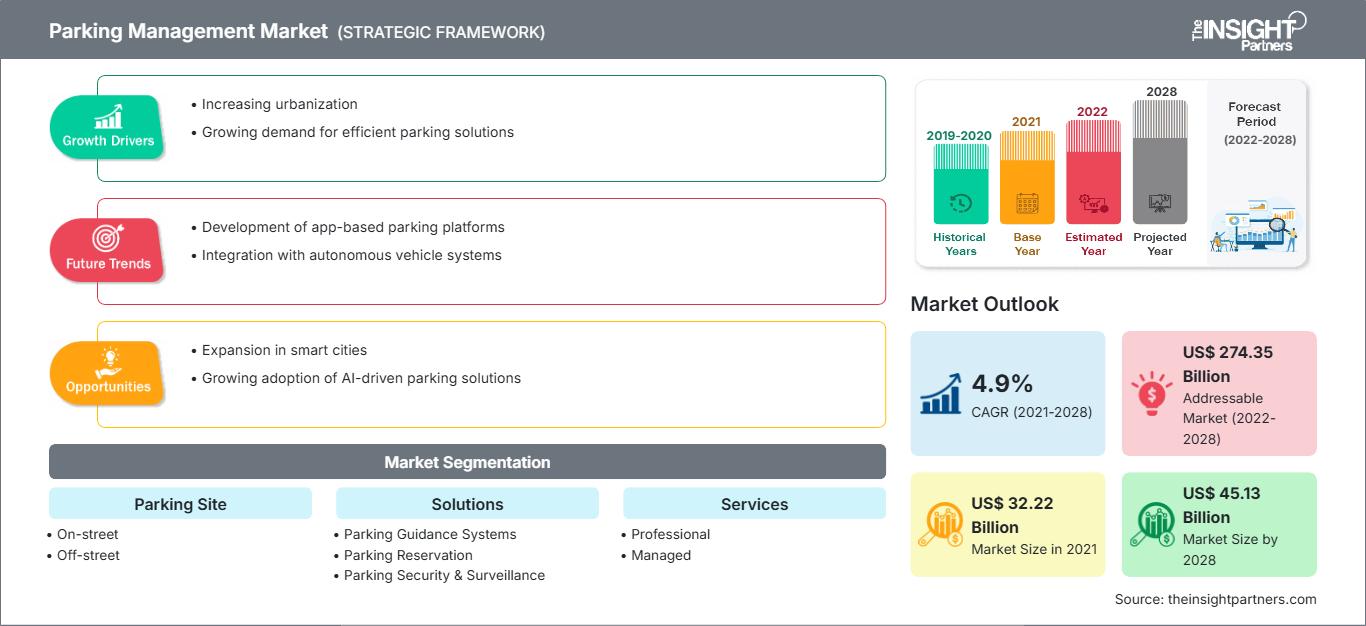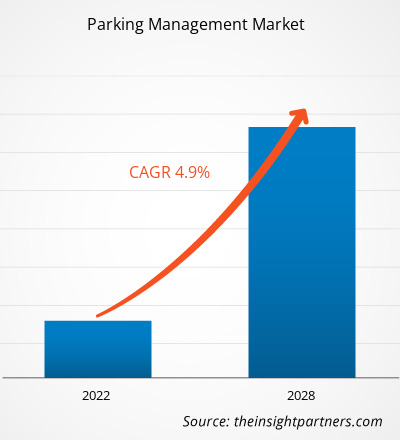Der Markt für Parkraummanagement soll von 32.221,73 Millionen US-Dollar im Jahr 2021 auf 45.125,82 Millionen US-Dollar im Jahr 2028 wachsen; die durchschnittliche jährliche Wachstumsrate (CAGR) liegt zwischen 2021 und 2028 bei 4,9 %.
Großstädte in mehreren Ländern weltweit setzen verstärkt auf intelligente Technologien, um den täglichen Verkehr und die Parkprobleme zu reduzieren. Verkehr und Parkplätze sind sowohl in Industrie- als auch in Schwellenländern weltweit seit langem ein Problem. Intelligente Parktechnologien revolutionieren derzeit das Parkraummanagement, und die Nachfrage nach intelligenten Parktechnologien wächst exponentiell. Zu den intelligenten Technologien, die im aktuellen Parkraummanagementsystem ein enormes Wachstum verzeichnen, gehören Parkleitinformationssysteme, automatisiertes Parken, intelligente Parkgebührensysteme und Parkplatzreservierungssysteme. Zusätzlich zu diesen Technologien steigt auch die Nachfrage nach Sicherheit und Schutz geparkter Fahrzeuge bei Fahrern und Fahrzeughaltern rapide an, was die Anschaffung von Parküberwachungssystemen vorantreibt und so im Laufe der Jahre erheblichen Marktraum für Wachstum von Parkraumbewirtschaftungsunternehmen schafft.
Auswirkungen der COVID-19-Pandemie auf den Parkraumbewirtschaftungsmarkt
Die COVID-19-Pandemie hat mehrere Branchen weltweit erschüttert. Der Lockdown behinderte den Betrieb verschiedener Branchen, darunter Fertigung und IT. Wichtige Branchen wie die Produktion schnelldrehender Konsumgüter (FMCG) und die Pharmaindustrie mussten jedoch ihren Betrieb fortsetzen. Der Ausbruch hat zu Störungen in Primärindustrien wie der Elektronik-, Halbleiter- und Automobilindustrie geführt. Ein starker Wachstumsrückgang in den genannten Branchen begrenzt das Wachstum des Parkraumbewirtschaftungsmarktes. Fabrikschließungen, Reise- und Handelsverbote sowie Grenzschließungen zur Bekämpfung und Eindämmung der Infektion haben den Betrieb vieler Gewerbe- und Firmengebäude weltweit beeinträchtigt. Derzeit sind die USA aufgrund des COVID-19-Ausbruchs das weltweit am stärksten betroffene Land. Die meisten öffentlichen Einrichtungen und Kommunen sind auf Parkgebühren und Parkeinnahmen angewiesen, um zahlreiche Großprojekte für die Bürger des Landes zu finanzieren. Firmengebäude, Geschäftsviertel, Universitäten, Einkaufszentren, Krankenhäuser, Hotels, Flughäfen und viele andere verfügen über hervorragende Parkmöglichkeiten und -dienste, um ihre Geschäftsfunktionen effizient zu bewältigen. Aufgrund der Auswirkungen der COVID-19-Pandemie, der geschäftsübergreifenden Aktivitäten und der Einhaltung der sozialen Distanz zur Verlangsamung der Virusausbreitung ist die Parkbranche stark betroffen. Viele Unternehmen stehen unter enormem Überlebensdruck, und Hunderttausende von Mitarbeitern im Servicebereich verlieren ihren Arbeitsplatz. Die Echtzeitüberwachung der Dynamik von über 2.000 Parkeinrichtungen in ganz Nordamerika sowie die Beobachtungen helfen, die Auswirkungen von COVID-19 auf das Parken quantitativ zu verstehen.
Passen Sie diesen Bericht Ihren Anforderungen an
Sie erhalten kostenlos Anpassungen an jedem Bericht, einschließlich Teilen dieses Berichts oder einer Analyse auf Länderebene, eines Excel-Datenpakets sowie tolle Angebote und Rabatte für Start-ups und Universitäten.
Markt für Parkraumbewirtschaftung: Strategische Einblicke

-
Holen Sie sich die wichtigsten Markttrends aus diesem Bericht.Dieses KOSTENLOSE Beispiel umfasst Datenanalysen, die von Markttrends bis hin zu Schätzungen und Prognosen reichen.
Der Markt für Parkraummanagementsysteme ist weltweit stark fragmentiert, da mehrere Akteure mit ihren jeweiligen Technologien und Dienstleistungen in der Branche tätig sind. Dies hat zu erheblichen Komplexitäten für die Endnutzer von Parkraummanagementsystemen geführt. Der Bedarf und die Nachfrage nach technologisch verbesserten Parkraummanagementsystemen steigen sowohl in den entwickelten Regionen als auch in den Schwellenländern weltweit kontinuierlich an. Die Akteure des Parkraummanagementmarktes haben in naher Zukunft erhebliche Wachstumschancen, indem sie Partnerschaften mit anderen Parkraummanagementdienstleistern und Regierungen eingehen. Partnerschaften zwischen den Dienstleistern erleichtern die Bereitstellung maßgeschneiderter Dienste, die den Markt voraussichtlich stark ankurbeln werden. So hat Passport im Juli 2021 dank einer Partnerschaft mit Xevo, einem führenden Unternehmen für Connected-Car-Technologien und innovative Benutzererlebnisse, die direkte Bezahlung von Parkgebühren über das Uconnect-Infotainmentsystem in Fahrzeugen der Marken Chrysler, Dodge, Jeep und Ram ermöglicht. Ebenso hat T2 Systems, ein Parktechnologieunternehmen, im Jahr 2020 mit TEZ, den Entwicklern von TEXT2PARK, zusammengearbeitet, um T2 MobilePay anzubieten, eine mobile Parkzahlungslösung, die Benutzern eine einfache und bequeme Methode bietet, für das Parken per Mobiltelefon zu bezahlen, während den Betreibern die Kontrolle über ihre Daten und Einnahmen bleibt.
Parkplatzbasierte Markteinblicke
Basierend auf dem Parkplatz ist der globale Markt für Parkraummanagement in Parkplätze auf der Straße und Parkplätze abseits der Straße segmentiert. Im Jahr 2020 führte das Segment der Parkplätze abseits der Straße das Segment der Parkplätze an und hatte einen größeren Marktanteil.
Lösungsbasierte Markteinblicke
Basierend auf der Lösung ist der Markt für Parkraummanagement in Parkleitlösungen, Lösungen zur Parkplatzreservierung, Lösungen zur Parkplatzsicherheit und -überwachung und andere segmentiert. Im Jahr 2020 führte das Segment „Sonstige“ den Markt für Parkraummanagement an und hatte den größten Marktanteil.
Dienstleistungsbasierte Markteinblicke
Basierend auf Dienstleistungen ist der Markt für Parkraummanagement in Managed Services und Professional Services unterteilt. Im Jahr 2020 war das Segment Managed Services der Marktführer im Markt für Parkraummanagement und hatte einen größeren Marktanteil.
Bereitstellungsbasierte Markteinblicke
Basierend auf der Bereitstellung ist der Markt für Parkraummanagement in Cloud und On-Premise unterteilt. Im Jahr 2020 war das On-Premise-Segment der Marktführer im Markt für Parkraummanagement und hatte einen größeren Marktanteil.
Die Akteure im Markt für Parkraummanagement verfolgen Strategien wie Fusionen, Übernahmen und Marktinitiativen, um ihre Position auf dem Markt zu behaupten. Nachfolgend sind einige Entwicklungen wichtiger Akteure aufgeführt:
- Im August 2021 interagiert die Mobile Enforcement Software (MEA) von T2 Systems, eine App zur Ausstellung von Strafzetteln für iPhones, iPads und Android-Tablets, nun mit dem automatischen Kennzeichenerkennungssystem (ALPR) AutoVu von Genetec und bietet Parkvorgängen eine mobile LPR-basierte Durchsetzungslösung.
- Im August 2021 hat ParkMobile, die führende mobile Park-App in den USA, heute eine neue strategische Partnerschaft mit TIBA Parking Systems, einem Mitglied der FAAC-Gruppe – dem größten Hersteller von Parkmanagementsystemen in Nordamerika – bekannt gegeben, um kontaktlose Zahlungsoptionen an bewachten Parkhäusern anzubieten. Der globale Markt für Parkmanagement wurde wie folgt segmentiert:
Parkmanagement
Regionale Einblicke in den ParkraumbewirtschaftungsmarktDie Analysten von The Insight Partners haben die regionalen Trends und Faktoren, die den Parkraummanagementmarkt im Prognosezeitraum beeinflussen, ausführlich erläutert. In diesem Abschnitt werden auch die Marktsegmente und die geografische Lage im Parkraummanagement in Nordamerika, Europa, im asiatisch-pazifischen Raum, im Nahen Osten und Afrika sowie in Süd- und Mittelamerika erörtert.
Umfang des Marktberichts zum Parkraummanagement
| Berichtsattribut | Einzelheiten |
|---|---|
| Marktgröße in 2021 | US$ 32.22 Billion |
| Marktgröße nach 2028 | US$ 45.13 Billion |
| Globale CAGR (2021 - 2028) | 4.9% |
| Historische Daten | 2019-2020 |
| Prognosezeitraum | 2022-2028 |
| Abgedeckte Segmente |
By Parkplatz
|
| Abgedeckte Regionen und Länder |
Nordamerika
|
| Marktführer und wichtige Unternehmensprofile |
|
Dichte der Marktteilnehmer im Parkraummanagement: Auswirkungen auf die Geschäftsdynamik verstehen
Der Markt für Parkraumbewirtschaftung wächst rasant. Die steigende Nachfrage der Endnutzer ist auf Faktoren wie veränderte Verbraucherpräferenzen, technologische Fortschritte und ein stärkeres Bewusstsein für die Produktvorteile zurückzuführen. Mit der steigenden Nachfrage erweitern Unternehmen ihr Angebot, entwickeln Innovationen, um den Bedürfnissen der Verbraucher gerecht zu werden, und nutzen neue Trends, was das Marktwachstum weiter ankurbelt.

- Holen Sie sich die Markt für Parkraumbewirtschaftung Übersicht der wichtigsten Akteure
- Auf der Straße
- Abseits der Straße
Nach Lösungen
- Parkleitsysteme
- Parkplatzreservierung
- Parkplatzsicherheit & Überwachung
- Sonstige
Nach Diensten
- Managed Services
- Professional Services
Nach Bereitstellungstyp
- Cloud
- Vor Ort
Nach Geografie
-
Nordamerika
- USA
- Kanada
- Mexiko
-
Europa
- Frankreich
- Deutschland
- Italien
- Großbritannien
- Russland
- Restliches Europa
-
Asien-Pazifik (APAC)
- China
- Indien
- Süd Korea
- Japan
- Australien
- Rest der Asien-Pazifik-Region
-
Naher Osten und Afrika (MEA)
- Südafrika
- Saudi-Arabien
- VAE
- Rest von MEA
-
Südamerika (SAM)
- Brasilien
- Argentinien
- Rest von SAM
Firmenprofile
- Flowbird Group
- PASSPORT LABS, INC.
- T2 Systems, Inc
- TIBA PARKING SYSTEMS
- Group Indigo
- Precise ParkLink
- FlashParking
- Amano Corporation
- Robert Bosch GmbH
- Siemens AG
- Historische Analyse (2 Jahre), Basisjahr, Prognose (7 Jahre) mit CAGR
- PEST- und SWOT-Analyse
- Marktgröße Wert/Volumen – Global, Regional, Land
- Branchen- und Wettbewerbslandschaft
- Excel-Datensatz
Aktuelle Berichte
Verwandte Berichte
Erfahrungsberichte
Grund zum Kauf
- Fundierte Entscheidungsfindung
- Marktdynamik verstehen
- Wettbewerbsanalyse
- Kundeneinblicke
- Marktprognosen
- Risikominimierung
- Strategische Planung
- Investitionsbegründung
- Identifizierung neuer Märkte
- Verbesserung von Marketingstrategien
- Steigerung der Betriebseffizienz
- Anpassung an regulatorische Trends






















 Kostenlose Probe anfordern für - Markt für Parkraumbewirtschaftung
Kostenlose Probe anfordern für - Markt für Parkraumbewirtschaftung